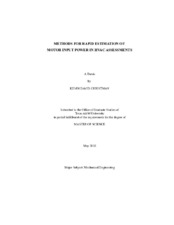| dc.description.abstract | In preliminary building energy assessments, it is often desired to estimate a motor's input power. Motor power estimates in this context should be rapid, safe, and noninvasive. Existing methods for motor input power estimation, such as direct measurement (wattmeter), Current Method, and Slip Method were evaluated. If installed equipment displays input power or average current, then using such readings are preferred. If installed equipment does not display input power or current, the application of wattmeters or current clamps is too time-consuming and invasive for the preliminary energy audit. In that case, if a shaft speed measurement is readily available, then the Slip Method is a satisfactory method for estimating motor input power.
An analysis of performance data for 459 motors suggests comparable performance for predicting normalized (to the nominal motor input power) motor input power with the Current and Slip Methods: 10.0% and 9.9% RMSE, respectively. Both of these methods may be improved by applying regression on the predicted variable and/or nameplate parameters. For example, the Slip Method could be improved by applying a second-order regression, thereby reducing the predicted load factor residual RMSE of the data set from 9.0% to 8.2%. The Current and Slip Methods were also evaluated on two real motors. The normalized (to the nominal motor input power) predicted input power RMSE for the Current Method was on average 15% for the two motors; for the Slip Method the corresponding average was 17.5%.
In some cases, shaft speed measurements may not be available. A temperature-based approach for estimating motor input power was investigated. Other required parameters include ambient temperature, motor efficiency, and a motor thermal constant. The temperature approach offers quick, safe, and non-invasive motor power estimation. However, thermal coefficients may vary significantly across motors and a model to predict the thermal coefficients has yet to be developed. Furthermore, the temperature approach has a very strong dependence on motor efficiency uncertainty. Experiments were performed on two motors to determine their motor thermal constants. If a motor's thermal constants and running efficiency are known, then this method gave motor input power estimates with a RMSE (normalized to the nominal input power) on the order of 4% for the studied motors. | en |


